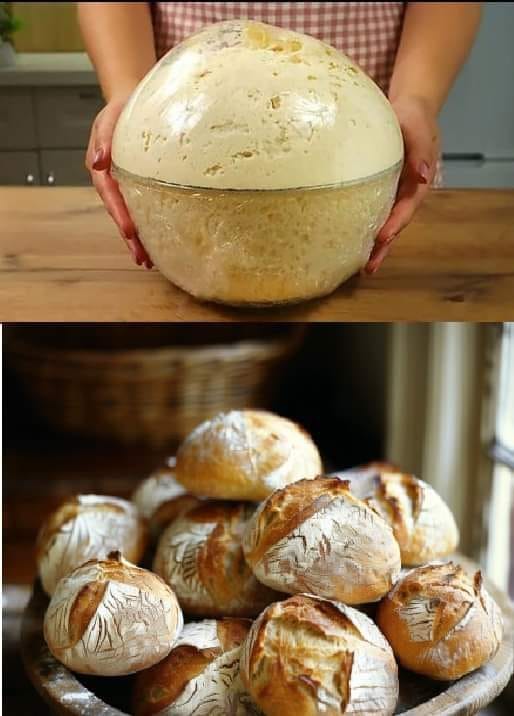ADVERTISEMENT
Instructions
Step 1: Prepare the Yeast
- In a small bowl, combine the warm water, sugar, and yeast. Let it sit for about 5-10 minutes until it becomes frothy. This step activates the yeast, ensuring your bread will rise.
Step 2: Mix the Dry Ingredients
- In a large mixing bowl, combine the flour and salt. If you’re adding herbs for flavor, mix them in at this stage.
Step 3: Combine Wet and Dry Ingredients
- Make a well in the center of the flour mixture and pour in the yeast mixture and melted butter. Stir until a shaggy dough forms.
Step 4: Knead the Dough
- Turn the dough out onto a lightly floured surface. Knead for about 8-10 minutes until the dough is smooth and elastic. If the dough is too sticky, add a little more flour as needed.
Step 5: First Rise
- Place the kneaded dough in a lightly greased bowl, cover it with a clean kitchen towel or plastic wrap, and let it rise in a warm place until it doubles in size, about 1-2 hours.
Step 6: Shape the Loaf
- Once risen, punch down the dough to release the air. Turn it out onto a floured surface and shape it into a loaf by flattening it into a rectangle and rolling it up tightly from the shorter side.
Step 7: Second Rise
- Place the shaped loaf in a greased loaf pan, seam side down. Cover it again and let it rise for another 30-60 minutes, or until it has risen above the edge of the pan.
Step 8: Bake the Bread
- Preheat your oven to 375°F (190°C). Bake the bread for 30-35 minutes, or until it is golden brown and sounds hollow when tapped on the bottom.
Step 9: Cool and Serve
- Remove the bread from the oven and let it cool in the pan for 10 minutes before transferring it to a wire rack. Allow it to cool completely before slicing. Enjoy it plain, with butter, or as the base for a delicious sandwich.
Tips for Successful Bread Baking
- Measure Ingredients Accurately: Use a kitchen scale for the best results, as weight provides a more accurate measurement than volume.
- Keep an Eye on Temperature: Yeast is sensitive to temperature. Ensure your water is warm but not hot to prevent killing the yeast.
- Be Patient: Allowing the dough to rise properly is crucial for achieving a light and airy texture. Don’t rush this step!
- Experiment with Flavors: Add seeds, nuts, dried fruits, or spices to customize your bread to suit your taste.
A Tradition Worth Passing Down
Baking bread is not just about the final product; it’s about the love and care that goes into the process. My grandmother’s timeless recipe has been shared among family members for generations, each loaf carrying with it the essence of home and togetherness. As you bake this bread, remember that you’re not just following a recipe; you’re continuing a beautiful tradition that connects you to the past.
Conclusion
The Ultimate Bread Baking Guide is your roadmap to creating a delicious loaf that will fill your home with warmth and aroma. With this timeless recipe passed down from my grandmother, you’ll be well on your way to mastering the art of bread baking. So, roll up your sleeves, embrace the process, and enjoy the fruits of your labor with family and friends!
Happy baking! May your kitchen be filled with the comforting scent of homemade bread!
ADVERTISEMENT
